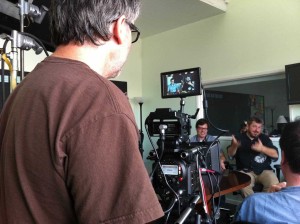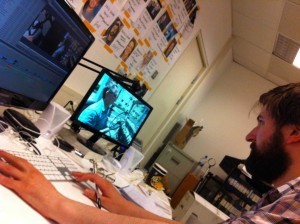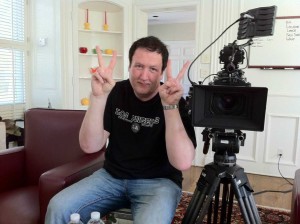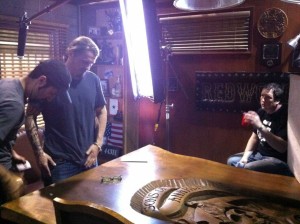
Dublin-born cinematographer, Des Doyle, makes his directing debut with Showrunners: The Art of Running a TV Show, a documentary feature that explores the inner workings of the American television industry and the writer/creators that manage every aspect of a television show’s development and production. American series have fascinated the director since childhood, having grown up on a heavy diet of shows such as Star Trek, Twin Peaks and The X-Files. He could not believe that no one had made a film about the creators of these television series.
Forming the film’s narrative from extensive interviews with the talent behind Lost, Boardwalk Empire, The Big Bang Theory, The Good Wife, Sons of Anarchy, Spartacus, Buffy the Vampire Slayer, Battlestar Galactica, Person of Interest and Revenge, Doyle allows these chief writer/producers to tell their own story, in their own “voice.” Visually, the film uses the backdrop of billboards and life on the streets of Hollywood, along with behind-the-scenes access to chronicle the journey of the shows, as well as track the creation of a pilot, exposing the process every step of the way.
To succeed at one the most complex jobs in the entertainment business requires a constant balancing act between art and commerce. The film reveals the individual showrunning styles – as diverse as the series themselves – that these storytellers employ to steer their collaborators in the writers’ room, during production and through post to produce the elusive hit that makes all the pressure and personal costs worth sacrificing.
 As is often the case with independent documentaries, the production had a long schedule – over a four-year period. Doyle brought the original idea to the Irish Film Board around 2010. “I got incredibly lucky that the executive that I happened to pitch it to was also as big a fan of American TV as I was,” shared Doyle. “The Film Board gave us some money to come over and prove that we could get access to some people, that we could get them saying something interesting on camera, that there was some kind of story or narrative we could build around.”
As is often the case with independent documentaries, the production had a long schedule – over a four-year period. Doyle brought the original idea to the Irish Film Board around 2010. “I got incredibly lucky that the executive that I happened to pitch it to was also as big a fan of American TV as I was,” shared Doyle. “The Film Board gave us some money to come over and prove that we could get access to some people, that we could get them saying something interesting on camera, that there was some kind of story or narrative we could build around.”
When Doyle first arrived in the US, he did not know anybody and had no track record. “Gaining access to people was certainly a difficulty when we first came. It took about four months to get the first people on camera. Even trying to get an hour with those guys is a complicated process,” said Doyle
Things changed when Daman Lindelof (Lost) agreed to an interview. “He is obviously such a name. Lost was such a big show,” said Doyle. “He gave a really great interview. A really candid interview.” The filmmakers were able to cut that interview with some other footage and put together a sizzle reel for the Film Board that they also released within the industry in the U.S. “A lot of writers and assistants picked it up and started sharing it around,” revealed Doyle. Co-producer and second unit director, Ryan Patrick McGuffey, added, “It ended up going viral rather quickly.”
 When the filmmakers returned to the States for a second round of filming, instead of Doyle cold-calling and having to explain the premise of the documentary as he had done on the previous trip, people had seen the sizzle and knew what the project was about. “That really did help. Then its starts to have a snowball effect,” explained Doyle. “You get one person, and then another, and then another. It took us about a year to get to Josh Whedon and about 18 months to get to J.J. Abrams. They were people I always wanted from the beginning. It was fantastic to be able to include them.”
When the filmmakers returned to the States for a second round of filming, instead of Doyle cold-calling and having to explain the premise of the documentary as he had done on the previous trip, people had seen the sizzle and knew what the project was about. “That really did help. Then its starts to have a snowball effect,” explained Doyle. “You get one person, and then another, and then another. It took us about a year to get to Josh Whedon and about 18 months to get to J.J. Abrams. They were people I always wanted from the beginning. It was fantastic to be able to include them.”
Although part of the job as a showrunner is to, as Doyle explained, “Go out and bang the drum for your own show,” the types of questions that he asked his subjects were out of the norm of what they were usually asked. It was not about the stars or what was coming up next year on the show.
“It’s like, why are you writing this show? What’s it like to be a showrunner? What goes on during your day?” said Doyle. “From that point of view, they actually started talking to us, and we always tried to have conversations rather than interviews. They did relax. For example, when we went to interview Michelle and Robert King from The Good Wife, we were told that we had 30 minutes because The Hollywood Reporter was coming in after us. They made The Hollywood Reporter wait and gave us an hour because they were enjoying the conversation. It was the kind of stuff they don’t usually get to talk about.”
Getting extended coverage of the shows to go with the interviews took months to organize and get the clearances from the studios, the actors and everybody involved. “In a weird kind of a way, it worked to our advantage, because it seems that over those four years showrunners have risen in prominence and interest,” noted Doyle.
 Although Doyle is a cinematographer, he realized early on that he did not want to operate a camera when he was trying to sit down and have a conversation. His primary director of photography for the film was Alan Calzatti (Heima). Other camera operators were used depending on filming circumstances, such as when more than one camera was needed to capture everything that was going on, be it in the writers’ room or on-set. “Alan is a very nice lighter,” said Doyle. “I am very happy with how the film looks cinematically speaking.”
Although Doyle is a cinematographer, he realized early on that he did not want to operate a camera when he was trying to sit down and have a conversation. His primary director of photography for the film was Alan Calzatti (Heima). Other camera operators were used depending on filming circumstances, such as when more than one camera was needed to capture everything that was going on, be it in the writers’ room or on-set. “Alan is a very nice lighter,” said Doyle. “I am very happy with how the film looks cinematically speaking.”
Because of his background, Doyle was very specific about which cameras and lenses were used. The film was shot on a variety of RED cameras, except when shooting in smaller space where it was easier to use smaller cameras. In those cases some of the Canon cameras were operated. With the RED, Zeiss lenses were used to give some depth and a more cinematic look.
All postproduction for the film was done in Ireland, but the by the time they got to editing, they had exhausted their limited budget. They ran a Kickstarter campaign for the final leg of the filmmaking process. Even some of the showrunners donated to the finishing fund. “They tweeted about it. They posted about it,” said Doyle. “To have that backing and support and feel that people really did want it to happen was fantastic.”
As a first-time director, this was Doyle’s first collaboration with John Murphy, a veteran documentary editor. With about a hundred hours of footage, it took about a year to shape the narrative. “While we had the main through stories, there were a million other ways to build the film around that. We went six months in and thought that we weren’t actually doing it the best way that we could,” explained Doyle. “We stopped and started again.”
McGuffey shared a bit of his experience with the editing process, “It was kind of hilarious. They’d find a hole or something that they’d need B-roll to cover-up. I’d get a call. ‘Would you mind going out to shoot some billboards or something?’ It really did come together in the edit.”
Some footage had to be omitted from the cut because material could not be cleared. “I have to say a lot of the studios and networks have been incredibly supportive of us, but unfortunately some weren’t after a lengthy period of negotiation. That also meant that very late in the day, we had to go back and film, re-edit and make changes because we weren’t able to clear certain things,” Dole said.
In the course of making the film and promoting it in film festivals internationally, Doyle was impressed by how much American television resonates abroad. “It’s global. It’s universal.” Dole concluded. “No matter where you go, you turn on the TV. There’s Friends or Seinfeld. I did a job in Qatar and turned on the TV. Legend of the Seeker was on. I was in Berlin for the Berlin Film Festival this year. I met all these guys who were just obsessed with The Big Bang Theory. It’s beloved around the world.”





